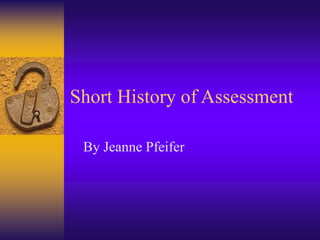shorthistoryassessment.ppt
•Download as PPT, PDF•
0 likes•2 views
Historical background of assessment
Report
Share
Report
Share

Recommended
Research in Distance Education:
from present findings to future agendas. Evaluation and Assessment strand presentation.
Dr Wayne Morrison
External Laws ProgrammeCDE Conference 09/02/2009. W Morrison. Assessment and evaluation in UG Laws: ...

CDE Conference 09/02/2009. W Morrison. Assessment and evaluation in UG Laws: ...Centre for Distance Education
Recommended
Research in Distance Education:
from present findings to future agendas. Evaluation and Assessment strand presentation.
Dr Wayne Morrison
External Laws ProgrammeCDE Conference 09/02/2009. W Morrison. Assessment and evaluation in UG Laws: ...

CDE Conference 09/02/2009. W Morrison. Assessment and evaluation in UG Laws: ...Centre for Distance Education
More Related Content
Similar to shorthistoryassessment.ppt
Similar to shorthistoryassessment.ppt (20)
Teacher's hand out3rd 2 g evaluation meeting april 26th 2016

Teacher's hand out3rd 2 g evaluation meeting april 26th 2016
Measurement and Assessment in Teaching 11th Edition Miller Test Bank

Measurement and Assessment in Teaching 11th Edition Miller Test Bank
Field study 5 - Assessment and Evaluation of Learning

Field study 5 - Assessment and Evaluation of Learning
The Difference Between Assessment and Evaluation.ppt

The Difference Between Assessment and Evaluation.ppt
More from DrNajmonnisa
More from DrNajmonnisa (11)
gLNnUW_Midwest_HS_Student_Influences_Survey (1).pptx

gLNnUW_Midwest_HS_Student_Influences_Survey (1).pptx
Recently uploaded
This presentation was provided by William Mattingly of the Smithsonian Institution, during the closing segment of the NISO training series "AI & Prompt Design." Session Eight: Limitations and Potential Solutions, was held on May 23, 2024.Mattingly "AI & Prompt Design: Limitations and Solutions with LLMs"

Mattingly "AI & Prompt Design: Limitations and Solutions with LLMs"National Information Standards Organization (NISO)
https://app.box.com/s/4hfk1xwgxnova7f4dm37birdzflj806wGIÁO ÁN DẠY THÊM (KẾ HOẠCH BÀI BUỔI 2) - TIẾNG ANH 8 GLOBAL SUCCESS (2 CỘT) N...

GIÁO ÁN DẠY THÊM (KẾ HOẠCH BÀI BUỔI 2) - TIẾNG ANH 8 GLOBAL SUCCESS (2 CỘT) N...Nguyen Thanh Tu Collection
Recently uploaded (20)
Jose-Rizal-and-Philippine-Nationalism-National-Symbol-2.pptx

Jose-Rizal-and-Philippine-Nationalism-National-Symbol-2.pptx
Benefits and Challenges of Using Open Educational Resources

Benefits and Challenges of Using Open Educational Resources
Application of Matrices in real life. Presentation on application of matrices

Application of Matrices in real life. Presentation on application of matrices
INU_CAPSTONEDESIGN_비밀번호486_업로드용 발표자료.pdf

INU_CAPSTONEDESIGN_비밀번호486_업로드용 발표자료.pdf
Basic phrases for greeting and assisting costumers

Basic phrases for greeting and assisting costumers
slides CapTechTalks Webinar May 2024 Alexander Perry.pptx

slides CapTechTalks Webinar May 2024 Alexander Perry.pptx
Instructions for Submissions thorugh G- Classroom.pptx

Instructions for Submissions thorugh G- Classroom.pptx
Mattingly "AI & Prompt Design: Limitations and Solutions with LLMs"

Mattingly "AI & Prompt Design: Limitations and Solutions with LLMs"
Forest and Wildlife Resources Class 10 Free Study Material PDF

Forest and Wildlife Resources Class 10 Free Study Material PDF
Solid waste management & Types of Basic civil Engineering notes by DJ Sir.pptx

Solid waste management & Types of Basic civil Engineering notes by DJ Sir.pptx
GIÁO ÁN DẠY THÊM (KẾ HOẠCH BÀI BUỔI 2) - TIẾNG ANH 8 GLOBAL SUCCESS (2 CỘT) N...

GIÁO ÁN DẠY THÊM (KẾ HOẠCH BÀI BUỔI 2) - TIẾNG ANH 8 GLOBAL SUCCESS (2 CỘT) N...
Basic Civil Engineering Notes of Chapter-6, Topic- Ecosystem, Biodiversity G...

Basic Civil Engineering Notes of Chapter-6, Topic- Ecosystem, Biodiversity G...
Matatag-Curriculum and the 21st Century Skills Presentation.pptx

Matatag-Curriculum and the 21st Century Skills Presentation.pptx
shorthistoryassessment.ppt
- 1. Short History of Assessment By Jeanne Pfeifer
- 2. Major Changes in Assessment Norm Referenced Tests Criterion Referenced Tests Authentic Assessment
- 4. Norm Referenced Based on “the Bell Curve” Use standardized tests Comparing students to students Want to create a spread – Item analysis – Distinguish items: High achievers get correct and low achievers get wrong Used for screening people in and out
- 6. Criterion Referenced Specific standards established Certain information/learning is necessary to continue the next steps of learning. Students learning is compared to the criteria or standards (NOT to each other) Assumption: If students do not reach standards, find other means of teaching students Banks of testing items created to match different types of curriculum (mostly multiple items)
- 8. Authentic Assessment Not all of what we teach can be assessed by paper and pencil tests nor by multiple choice items Students need to demonstrate what they learned: performance based (based on constructivist learning theory) Assessment is different than testing or grading (closer to diagnosis) Multiple means of assessment
- 9. Examples of Authentic Assessment Rubrics (specific criteria—teaching is planned around criteria) Includes attention to non-academic or difficult to assess – Cooperative learning – Critical thinking skills – Social learning Differentiates summative vs. formative assessment Portfolios
- 10. Rubrics Have “layers” May be based on developmental levels May be “weighted” for different categories at different times of the years Need to be sensitive to the time to present to learners – Too early=overwhelming (haven’t taught it yet) – Too late=not useful for modifying or developing products Eventually students can develop rubrics (they have internalized the criteria)